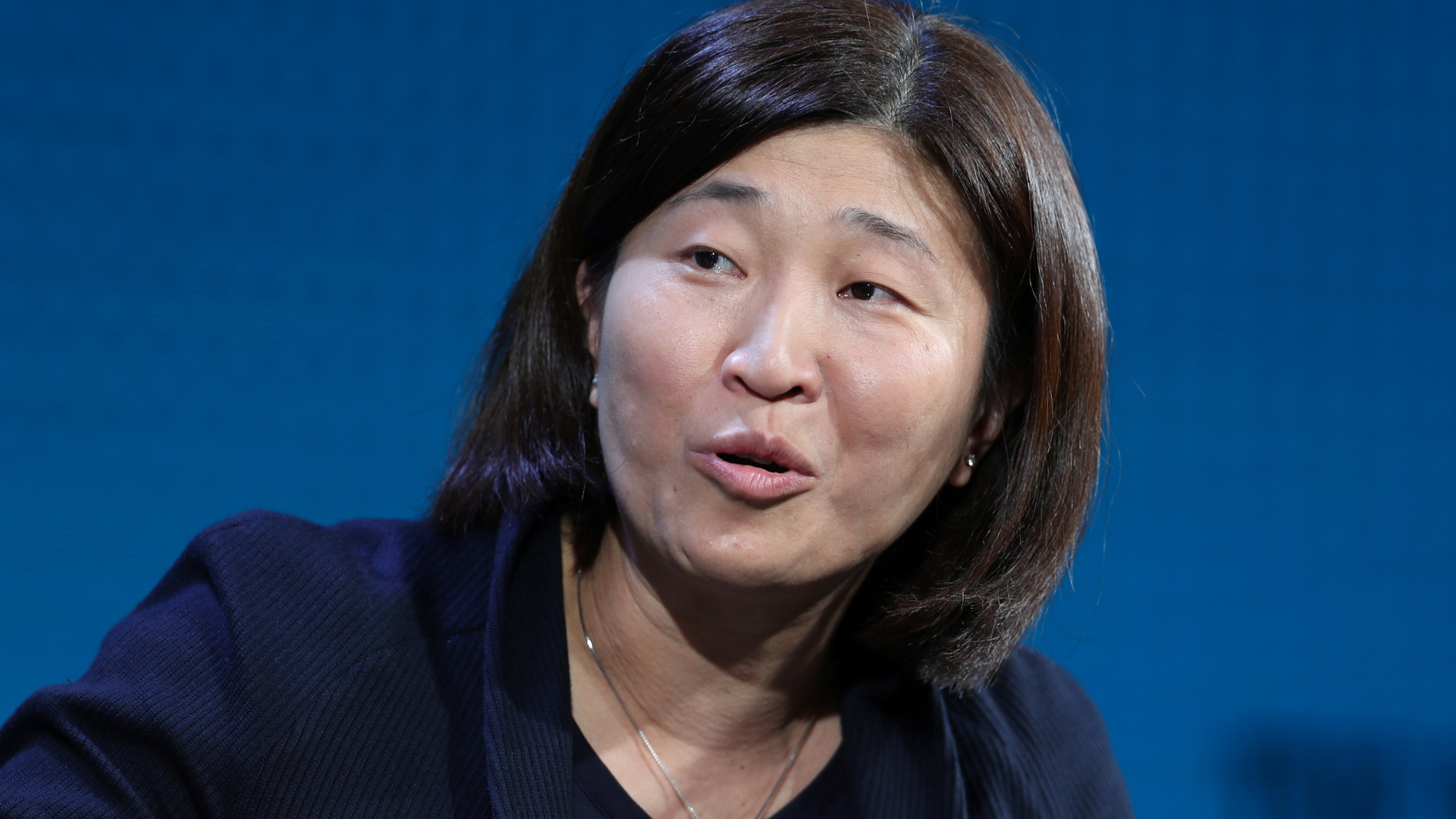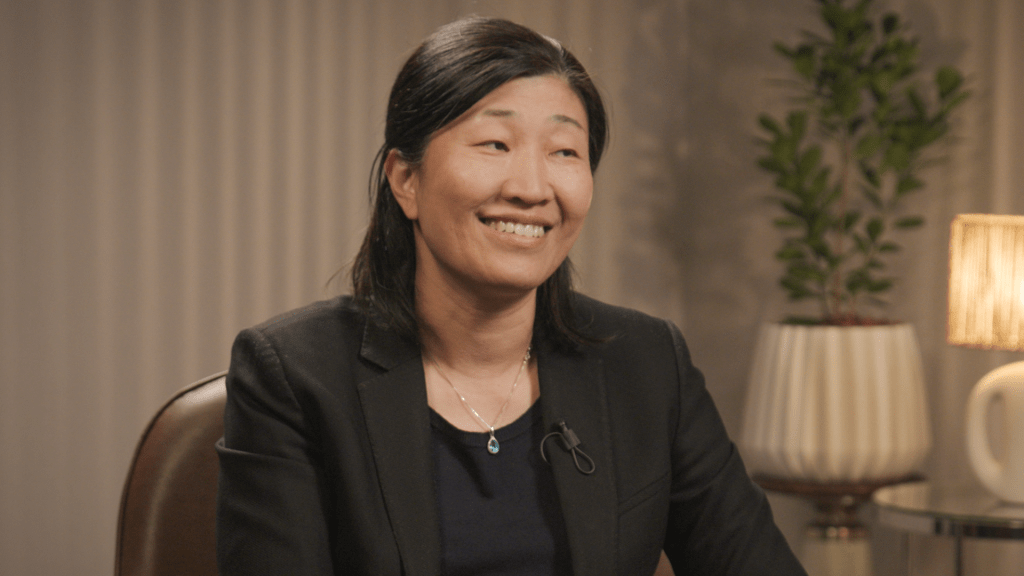Ever since she was a kid, Singaporean venture capitalist Jenny Lee has loved reading sci-fi.
Its visions of the future are something she draws on regularly as one of the world’s leading VCs. She tries to visualize how tech will reshape our lives – then hunts down the start-ups which have a shot of making that a reality. We’re talking anti-aging tech, printed food, flying cars.
“I like to see where the world is going to be 10 years from now, 20 years from now, 50 years from now – 100,” she tells Money Moves. “I think that the ability to imagine that is actually very important. And not just one outcome, but various outcomes.”
Before getting into venture capital, Lee started her career in another niche, highly technical, and male-dominated industry – working on fighter jets as an aircraft engineer at Singapore’s ST Aerospace. It wasn’t until six years later, after the company sent her to get an MBA in the US, that she realized she was interested in start-ups. She quit her job and took the plunge.
In what would prove typical Lee style, it was a bold gamble that paid off – big time. Today, Lee has a global reputation for picking winners that are redefining the tech landscape. Her firm, Granite Asia, boasts 49 unicorns (yes, 49) among its portfolio of about 300 companies. One marathon fund-raising push during the pandemic, where she raised $2.5 billion in 250 Zoom calls over four months, is the stuff of industry legend.
She sat down in Riyadh with Money Moves’ host Muhammed Mekki for a wide-ranging conversation about the process of turning sci-fi into reality, the differences between Asia and the West when it comes to innovation, and how VCs know when they’ve found a winner.

Here are three takeaways from the conversation:
- Efficiency matters more than ever. Many regions, especially Asia, aren’t awash in ready money for start-ups right now. That puts the onus on entrepreneurs to do more with less and think more deeply about the value they’re creating. “Is it real value that you’re creating, versus value that you can buy with marketing?” says Lee.
- Master the art of the pitch. For Lee, the introductory pitch is all about communicating the necessary passion and spark – proving you can clearly articulate a vision, and signaling you have the charisma and leadership to build towards it. All the tricky stuff comes later.
- Understand a business inside and out before you invest. Read the prospectuses. You need to be able to answer: why this business? Why now? And why this team? And when you do invest, do it in something you love – you have to become an expert in it.
Muhammed Mekki: You’re known for having been early on major trends, from AI to next-generation mobility to robotics. How do you spot the next wave?
Jenny Lee: As an investor, as a VC, it’s important to do visioning. That’s what I like to do. And since [I was] young, I’m a sci-fi fan, or fantasy reader.
What’s important to us as investors is that we then have to bring that future back to the present and say: Where’s the technology stack? Where’s the technology, in terms of the time to realize those core fundamental technologies into a market-facing product?
You have to find companies, find solutions that can actually get you to [the first generation product].
I used to upgrade fighter jets, so I used to design products. I have a very systematic view of the world. I have a photographic memory. Like when I look at a design system program, I can just imagine how it’s going to look. I think, in that sense, it does help when I’m looking at leveraging technology to create the next-generation products.
Read more: From App Store rejection to winning at Web3 – Yat Siu’s big comeback
- Mekki: You’ve said before that one of the hallmarks of a good investor is to be able to suspend disbelief about a project in order to really assess the opportunity in front of you. Can you tell us about an investment where you’ve really had to do that?
I love drones, right? I used to build drones 30 years ago. One of the startups that came to me initially was trying to do just hobby drones. It’s easy. There are a bunch of players there, the technology stack is not that bad. So it’s great.
But the thing that caught me when I went to do the due diligence was the fact that the founder had put a little lab in the back, and he had a human-sized transporter drone.
He said, ‘This is my dream 10 years down the road. If this works… I’m going to put all the earnings into this longer-term vision, which is flying cars.’
So actually, he may think that I invested because it was a good commercial [case]. But I invested because of the vision, and because I feel like someone has to do it. He has the right technology stack. He has the right vision. And that was quite fun.
- Mekki: Imagine a founder catches you in an elevator and wants to make that one-minute pitch for your investment. What are you looking for?
The one-minute pitch is a misnomer, right? The only thing you can get from the one-minute is whether the founder has passion, whether he or she is able to articulate that end vision.
Sometimes when you meet people, you see – whether it’s chemistry, whether it’s passion – that this person is special.
Being a leader is … a unique capability. Are you able to articulate that vision? Because you’re going to have to get people to follow you. In times of anxiety, can you get it together? I’ve seen 19-year-olds come across and present way better than serial entrepreneurs, even.
It’s about reading that vision, that spark. The one-minute allows you to say, ‘Do I want to spend more time?’ Usually, then we have a meeting, and you sit down and really give enough time and effort to understand what the dream and vision is.
You want to make sure that when you do write the check, it’s a very responsible and very educated decision.
Read more: Drones, copycats and tumor-shrinking chips – How Noor Sweid finds the next big thing
- Mekki: There’s sometimes a perception from outside Asia, looking in, that there’s a lot of copycatting, as opposed to genuine innovation, going on. What’s your take on that?
In my view, there are two types of innovation. One is the hardcore innovation. Going from 0 to 1. Coming up with algorithms, products, solutions, software that’s never been there before.
I think the second definition of innovation is actually business-model innovation. Operation-driven innovation, the applied type of innovation.
The East is better in applied, right? Because of the market that they’re in, because of where they are in their own phase of development – it’s the incremental innovations we talked about that are changing the lives of many people.
In the West, where mature economies are, then obviously you need to leapfrog, because everybody is pretty good.
And actually, the world needs both types of innovation.
Read more: Throw the accountant in the pool – How Moses Lo brought Silicon Valley to Southeast Asia
- Mekki: What’s exciting you at the seed stage now? Where are you placing your bets in terms of high-potential emerging tech?
We all understand this conversation about AI going to be the next internet. We don’t look at it as one vertical. We look at this as a horizontal enabler.
Where the disruption is going to happen is going to be in the verticals. Areas of health, longevity, fitness, wellness – is one vertical that’s really top of mind. As you look at the world population, the population’s aging very quickly. People are living longer. But it’s also about living well.
Recently we wrote a seed check into a company that’s doing anti-aging. Still very early, but they actually have very good results. Imagine you can freeze time. That’s one of the more recent crazy ideas.
Another is about food. Because with climate change, crops, duration, farming cycles – it’s all changed. So new technology needs to be in place across the technology stack to allow for better food resiliency. Supply options. How they store, prepare for, and basically create the right food structure is very important.
- Mekki: Tell us about how you know when you’ve come across a venture that’s right for you?
We have to be there, and we have to make the call. An analyst cannot articulate this. In new areas, new innovation – we have to feel it. I don’t know how to describe… gut feel. You just feel like the stars are aligned.
- Mekki: When was the last time you felt that?
All the time. I love my job.
Read more: Meet the part-time DJ, full-time tycoon who wants to make you richer
- Mekki: Finally, a little experiment we like to ask of our guests. Imagine you’re starting out in your career and have pulled together your first $10,000 to invest. What do you do with it?
I’ll share my experience. What I did on my own, many years back, is that I have a genuine interest in business. I want to know: what are the pieces that make a business successful?
So when I had a bit of cash myself, during the internet bubble, the one thing I did was I actually read a lot of IPO prospectuses. Just educating myself… broadly to the types of companies that were out there.
It’s the first step, learning how to read the information that’s out there. Make sure that you know what are the key drivers, and what other key issues that analysts are talking about.
Number two, you have to love the sector. I was an early investor – very early – in Tesla, because I watched the IPO presentation. I said: ‘This guy is cool. He’s basically saying we are not an automotive company, we are a platform.’
Then, of course, I drove my first Tesla. I said: ‘OK, that’s it. This company is going to be great.’
Edited by Lin Noueihed. If you have any tips, ideas or feedback, please get in touch: talk-to-us@moniify.com






